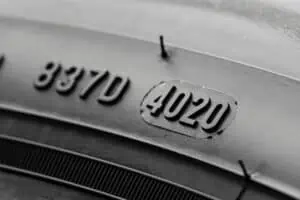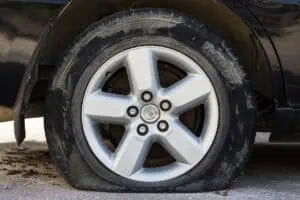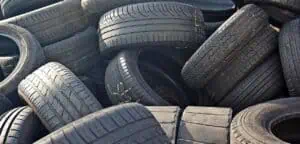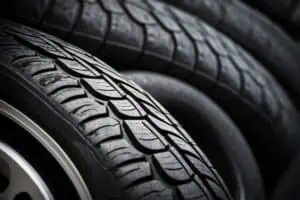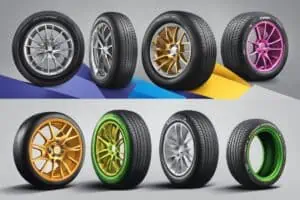Have you ever squatted down beside your car, looked at your tire, and wondered, “What’s the story behind these numbers and letters?” Well, it’s not a cryptic code meant only for tire experts; it’s valuable information that every driver should be aware of.
Here’s a breakdown of what those markings on your tire sidewall mean, and how they relate to the safety and performance of your vehicle.
Contents:

The Basics of Tire Markings
It’s more than just a collection of random numbers and letters. Each symbol etched onto your tire tells a tale about its specifications and capabilities.
Most commonly, you’ll find a format resembling this: P225/60R16. Let’s dive deeper.
Breaking Down the Number System
Passenger or Truck?
When your tire starts with a “P”, it’s whispering to you that it’s made for passenger vehicles. But if it’s shouting “LT”, then it’s rugged enough for a light truck.
While these might be the most common service types, there are others to be mindful of, and each plays a crucial role in understanding the tire’s design and function.
Section Width: a.k.a Tire Width
Next in line is a three-digit number, like the ‘225’ from our example. This isn’t some secret club code; it’s the tire’s width, measured in millimeters.
When you’re checking out this width, you’re essentially seeing how wide the tire spreads out across the wheel, from one sidewall to the other.
Aspect Ratio: Sidewall Height
The aspect ratio can be a bit tricky, but once you know the secret, it’s pretty simple. The two-digit number following the slash, let’s take ’60’ from the example, represents the height of the tire’s sidewall as a percentage of its width.
So, a 60 aspect ratio means the sidewall height is 60% of the tire’s section width. It’s a neat ratio that plays a pivotal role in your vehicle’s handling and ride comfort.
Construction Type: Radial or Bias Ply?
A small letter peeks out after the aspect ratio. If it’s an “R”, your tire boasts radial construction. Radial tires have layers of fabric with cords running at right angles to the tire’s tread, improving its treadwear and traction on the road.
On the other hand, if you spot a “D”, you’re looking at diagonal or bias ply construction. This older style has cords running diagonally across the tire, which might not be as efficient as the radial but has its own set of benefits.
Diameter: The Perfect Fit
Finally, wrapping up this sequence is a two-digit number, like ’16’ in our previous example. That’s the diameter, folks. It represents, in inches, the size of the wheel that the tire is designed to fit.
Getting the right diameter is essential; think of it as ensuring you have the perfect-sized shoes for your feet. Too big or too small, and you’re in for a bumpy ride.
Other Crucial Markings on Your Tires
Now that we’ve unraveled the mystery of the standard tire code, there are a few more markings that deserve your attention.
They might seem secondary, but in the grand world of tires, they carry their weight in gold.
Load Index & Speed Rating
Tucked away, often after the diameter number, you might spot another number followed by a letter. This duo is none other than the load index and speed rating.
The load index is a numerical code that corresponds to the maximum weight the tire can carry. Higher numbers mean more weight.
The letter following the load index? That’s the speed rating. It signifies the max speed the tire can handle when correctly inflated and under its load limit. From L (75 mph) to Z (over 149 mph), each letter tells a tale of speed.
It’s not just about pushing the pedal to the metal; it’s about safety and ensuring your tire can keep pace with your driving habits.

Decoding the Mystery: What’s a Tire Identification
Number?
We’re about to take a deep dive into the
world of Tire Registration Number or as most call it, Tire Identification Numbers (TIN). Trust me, it’s more exciting
than it sounds!
The Secret Code on Your Rubber
Picture this: you’re kicking the tires (literally) on a potential new ride, and you notice a cryptic code etched into the
sidewall. That, my friend, is the Tire Identification Number. It’s like a birth certificate for your tire, telling you
everything from its age to its place of origin. Let’s break it down, shall we?
How to Read a Tire Identification Number: A Step-by-Step Guide
Alright, let’s roll up our sleeves and get into the nitty-gritty of reading a TIN. Here’s a step-by-step guide that’ll make
you feel like a secret agent decoding classified information:
- Find the TIN: First things first, you need to locate the TIN on your tire. It’s usually molded into the sidewall, but
here’s a pro tip: it might only be on one side of the tire. So, if you don’t see it right away, don’t panic! Just take a
stroll to the other side. Look for a code that starts with “DOT” – that’s your cue that you’ve hit the jackpot. - Identify the DOT prefix: The letters “DOT” kick off the TIN. This stands for “Department of Transportation” and
is basically Uncle Sam’s stamp of approval. - Plant Code: The next two characters tell you where your tire was born. Each manufacturing plant has its own
unique code. It’s like the tire’s hometown! - Size Code: The following two characters represent the tire size and type. It’s basically telling you, “Hey, I’m built
for a specific kind of vehicle!” - Optional Code: The next four characters are where things get a bit mysterious. Manufacturers use this space for
their own internal codes. It could be anything from the tire’s materials to specific construction details. It’s like the
tire’s secret recipe! - Date Code: The last four digits are the golden nugget of information. These tell you when your tire was
manufactured. The first two numbers represent the week, and the last two represent the year.
Let’s look at a real-world example to bring this to life:
DOT A1 B2 C3D4 1234
In this case:
A1 is the plant code
B2 is the size code
C3D4 is the optional code
1234 means the tire was manufactured in the 12th week of 2034
Where’s the TIN on a Tire?
Now that you know what to look for, let’s talk about where to find it. The TIN is always molded into the sidewall of the
tire, but here’s the kicker – it might only be on one side!
Why, you ask? Well, it’s not to make your life difficult (although it might feel that way sometimes). It’s actually for
safety reasons. The side of the tire facing outward is more likely to get scuffed or damaged, so putting the TIN on the
inner side helps protect this crucial information.
So, next time you’re tire-hunting, remember:
- Check both sides of the tire
- Look for raised letters and numbers
- Find the “DOT” prefix – that’s your starting point
DOT Number
Don’t be fooled by the seemingly mundane “DOT” abbreviation on your tire. This Department of Transportation (DOT) number is a gateway into your tire’s history.
The following series of numbers and letters can tell you where your tire was made and its manufacturing week and year. It’s like a mini time capsule, etched right onto your tire, providing an insight into its origin and age.
The 4-Digit DOT Code: Your Tire’s Birthday in Code
Remember those last four digits we talked about? That’s what we call the 4-digit DOT code, and it’s basically your tire’s
birthday. Let’s break it down:
The first two digits represent the week of manufacture (01-52)
The last two digits represent the year of manufacture
So, if you see “2318”, your tire was born in the 23rd week of 2018. Pretty neat, huh?
Is the DOT Number Playing Hide and Seek?
Here’s a fun fact: the complete TIN, including the date code, is required by law to be on at least one side of the tire. But
here’s the twist – it doesn’t have to be on both sides!
So, if you’re only seeing a partial TIN on one side, don’t worry. The full monty is probably hiding on the other side. It’s
like a tire Easter egg hunt!
Cracking the Code: How to Decode a DOT Code
Let’s put on our detective hats and decode a full DOT code. Here’s another example:
DOT U2LL LMLR 5107
DOT: Department of Transportation approval
U2: Manufacturing plant code
LL: Tire size code
LMLR: Manufacturer-specific code
5107: Manufactured in the 51st week of 2007
See? You’re practically a tire whisperer now!
The 4-Digit Number: Your Tire’s Time Stamp
We’ve touched on this, but let’s dive a little deeper. The 4-digit number at the end of the TIN is crucial for
understanding your tire’s age. Here’s why it matters:
- Tires degrade over time, even if they’re not being used
- Most manufacturers recommend replacing tires that are 6-10 years old, regardless of tread wear
- Knowing your tire’s age helps you make informed decisions about replacement
For example, if you see “3421” at the end of your TIN, your tire was made in the 34th week of 2021. If you’re reading
this in 2025, you know your tire is about 4 years old. Still got some life in it!
Why Should You Care?
Now, you might be wondering, “Why do I need to know all this? Can’t I just drive and be done with it?” Well, here’s the
kicker – understanding your TIN can actually save you money and keep you safer on the road. Here’s how:
- Age Matters: Tires, like fine wine, age over time. But unlike wine, older isn’t better when it comes to tires.
Knowing the manufacture date helps you gauge when it might be time for a replacement, even if the tread looks
good. - Recall Information: If there’s ever a recall on your tire model, the TIN is your golden ticket to finding out if your
specific tires are affected. It’s like having a VIP pass to tire safety information. - Performance Expectations: Different manufacturing plants might have slight variations in their processes.
Knowing where your tire comes from can give you insights into its expected performance. - Bragging Rights: Okay, this one’s just for fun. But imagine impressing your friends at the next barbecue by
decoding the secret messages on their car tires. You’ll be the life of the party! (Results may vary. We’re not
responsible for any eye-rolling that may occur.)
Understanding your Tire Identification Number is like having a secret decoder ring for your wheels. It’s a small detail
that can make a big difference in your vehicle’s safety and performance. Next time you’re out in your driveway or at the
tire shop, take a moment to check out those TINs.
Uniform Tire Quality Grading (UTQG)
Beyond the typical numbers and codes, you might encounter another set: the UTQG rating. Overseen by the DOT, the UTQG system measures three pivotal aspects of tire performance.
- Treadwear: How does the tire hold up over time? A higher number here means the tire tread could last longer.
- Traction: How effectively can the tire stop on wet roads? Ratings go from AA (highest) to C (lowest), giving you a grip on its performance.
- Temperature: Can the tire dissipate heat at high speeds? Again, with grades from A (best) to C (acceptable), it’s about ensuring your tires stay cool under pressure.
Conclusion
While it might seem like there’s a universe written on your tire’s sidewall, once you’ve got the hang of it, it’s as easy as reading your favorite book.
Knowing what each number and letter represents isn’t just about quenching your curiosity; it’s about driving confidently, ensuring everyone aboard’s safety, and optimizing your vehicle’s performance.
So, next time you’re by the curb or in a parking lot, take a moment to squat down and read the story your tire tells. And when someone else is puzzled by their tire’s tales, you’ll be ready to share the wisdom.
Edited by Ram Seth
